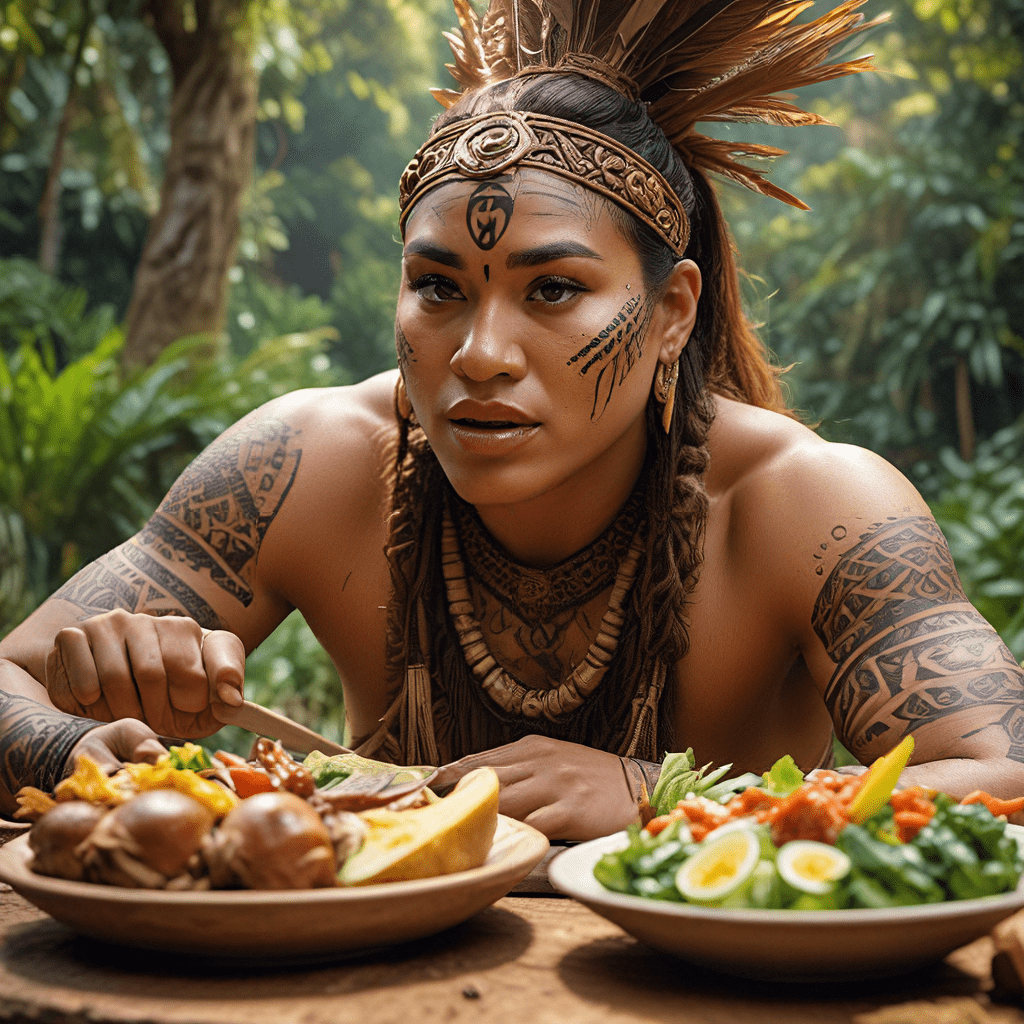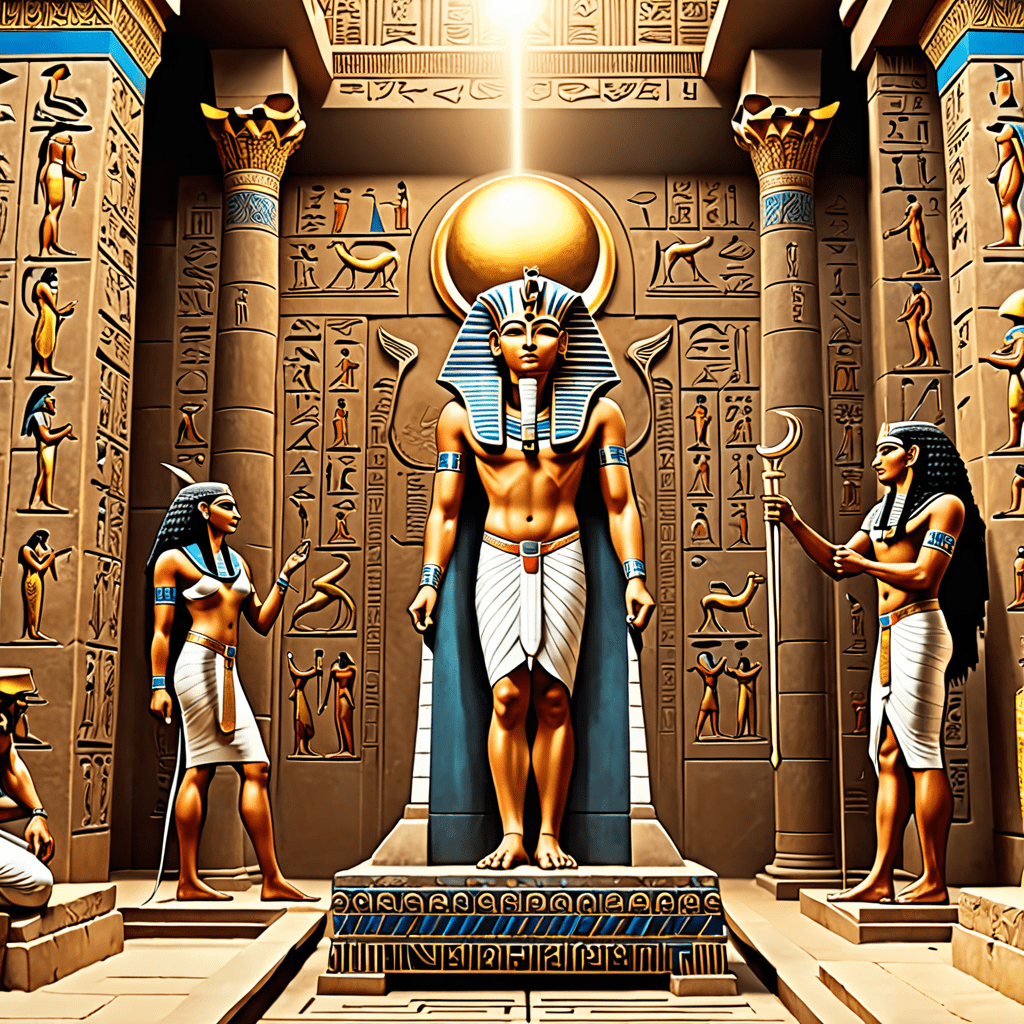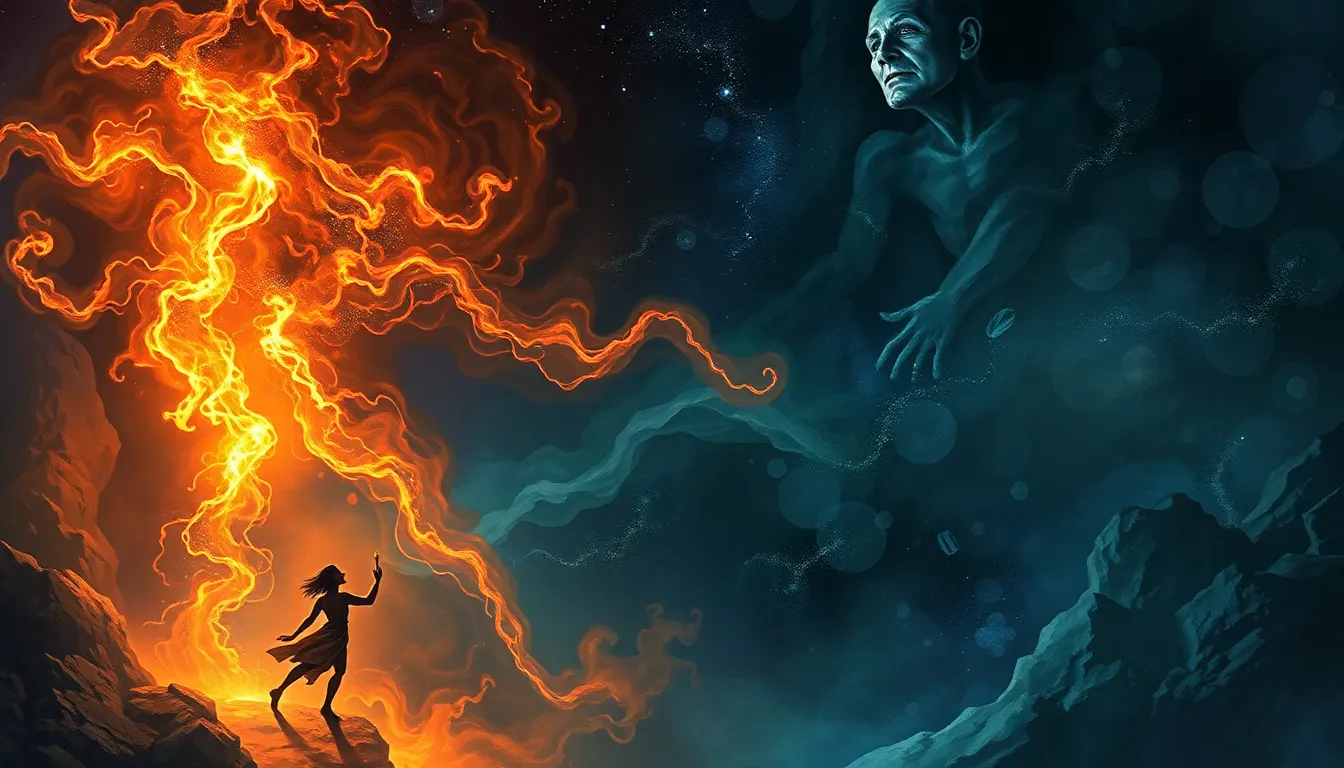Maori Cuisine: Where Mythology Meets the Plate
The rich tapestry of Maori culture is woven with stories, beliefs, and practices that have been passed down through generations. And at the heart of this cultural heritage lies a profound connection between mythology and traditional Maori cuisine.
The Genesis of Food: Maori Creation Myths and the Origin of Food
Maori mythology offers a captivating explanation for the very existence of food in the world. According to the creation myth, the gods, known as the atua, played a pivotal role in shaping the world and bringing forth the elements that sustain life.
The most famous creation myth, the story of "Tiki," tells of the god Tāne Mahuta, who emerged from the womb of his mother, Papatūānuku (Earth Mother), and separated his parents, Rangi (Sky Father) and Papatūānuku, creating the space for the world as we know it.
In this act of separation, Tāne Mahuta also brought forth the first trees which are essential to life. He took a branch from the first tree, a karaka, and planted it in the ground. This act of planting symbolizes the beginning of agriculture and the cultivation of food.
The story of the creation of the world and food serves as a reminder of the sacredness of nature and the importance of respecting the gifts that the gods have bestowed upon humanity.
Tāne Mahuta and the Sacredness of Trees: The Importance of Trees in Maori Cuisine and Mythology
In Maori mythology, Tāne Mahuta is revered as the god of forests and trees. He is considered the protector of all trees and is worshipped for his role in providing sustenance and shelter for humans.
The Maori people have a profound respect for trees, recognizing their importance as a source of food, medicine, and building materials. Maori cuisine is heavily reliant on products derived from trees, such as berries, roots, and nuts. The importance of trees in Maori society is reflected in the many proverbs and stories associated with them.
For example, the karaka tree is significant in Maori culture, symbolizing strength and resilience. In Maori cuisine, the karaka tree provides a fruit that was a staple food and a source of nourishment. The fruit was often preserved for later consumption and was considered a highly prized food.
The importance of trees in Maori culture is also reflected in the traditional art of carving. Maori artists would often create intricate carvings of trees, often incorporating symbolic representations of Tāne Mahuta and his role as the protector of the forest. These carvings served as a reminder of the importance of respecting nature and the interconnectedness of all living things.
Rongo and the God of Food: Maori Mythology’s Influence on Food Practices
Rongo, another important figure in Maori mythology, is known as the god of agriculture and food. The Maori people believe that Rongo is responsible for the growth of crops and the abundance of food.
Rongo is often depicted as a strong and benevolent figure, holding a hoe (digging stick) and a taro plant, symbols of his power over the land and his ability to provide sustenance for his people.
His influence on food practices is evident in many aspects of their culture. The Maori people practice a form of sustainable agriculture known as "whenua," which emphasizes the importance of respecting the land and using crops in a way that does not deplete the soil.
Furthermore, Rongo is associated with rituals and ceremonies related to food, such as the "hangi," a traditional underground oven used for cooking. It is common practice for Maori people to offer prayers to Rongo before harvesting crops or cooking food, a testament to the belief in his influence over the bounty of the land.
The Role of the Gods in the Maori Food Chain: The Interconnectedness of Myth and Daily Life
Maori mythology demonstrates a deep understanding of the interconnectedness of all living things. The gods are seen as integral to the natural world, actively shaping the food chain and influencing the daily lives of humans.
The roles of Tāne Mahuta (trees), Rongo (agriculture), and other gods demonstrate the importance of the natural world and the need for humans to live in harmony with it. Each god is responsible for a specific element of the food chain, highlighting the interdependence between humans and the gods.
This interconnectedness is also reflected in the Maori concept of "mana," a powerful force that flows through all living things, connecting them to the gods.
Maori people believe that by living in accordance with the will of the gods, they can maintain a connection to this powerful force and receive its blessings. This belief extends to food, as they believe that the gods can bestow abundance or scarcity upon their crops and livestock.
The Power of the Marae: The Sacred Space for Food and Ritual
The marae is a sacred space in Maori culture, serving as a focal point for community gatherings, ceremonies, and rituals. It is a place where people come together to celebrate their heritage, honor their ancestors, and seek guidance from the gods.
One of the key functions of the marae is to provide a space for communal meals. The marae is seen as a place of abundance and hospitality, where food is shared and enjoyed by the entire community.
The marae is also a place for ceremonies and rituals related to food. For example, the "hangi" ceremony often takes place on the marae. The hangi is a traditional Maori method of cooking food in an underground oven. It is a communal activity that involves the entire community and is seen as a way of honoring the gods and sharing the bounty of the land.
The marae is a powerful symbol of the deep connection between Maori culture, mythology, and food. It represents a place where people come together to celebrate their heritage, honor their ancestors, and seek guidance from the gods.
From Myth to Meal: How Maori Mythology Shaped Food Preparation and Consumption
Maori mythology has a significant impact on how food is prepared and consumed. These practices are not simply about taste; they are deeply connected to cultural values and beliefs passed down for generations.
One example is the hangi, a traditional method of cooking food underground using heated stones. This cooking method is not just practical; it symbolizes the connection between the Earth, the gods, and the food. The act of preparing a hangi is a ritual, often involving prayers and songs to honor the gods. The sharing of food cooked in this way signifies community, generosity, and the importance of connecting with the land.
Another example is the use of food offerings. In Maori culture, food is often presented as an offering to the gods, a way of showing respect and seeking their blessings. This practice is rooted in the belief that the gods influence the success of crops and livestock, and that by offering them a portion of the harvest, they will continue to provide abundance.
Maori cuisine also emphasizes the use of seasonal ingredients and the importance of sustainability. This practice connects directly to the mythology of Rongo, the god of agriculture. Maori people understand that the land must be respected and nurtured to provide ongoing sustenance. They use traditional methods of farming and gathering, ensuring that the environment is not depleted. The use of seasonal ingredients also reflects the understanding that nature provides different foods at different times of the year.
These practices are not just about food; they are about honoring the gods, respecting the environment, and celebrating cultural heritage. They demonstrate the deep connection between Maori mythology and their everyday lives.
The Maori Concept of Tapu (Sacredness) and Noa (Common): The Influence on Food Restrictions and Taboos
The Maori concept of Tapu (sacredness) and Noa (common) plays a crucial role in defining food restrictions and taboos. These concepts are not simply about what is edible and what is not; they reflect a deeper understanding of the relationship between humans and the supernatural world.
Tapu involves a sense of sacredness and restriction, often associated with deities, ancestors, or sacred places. Food can be considered Tapu for various reasons, such as:
- Being a part of a ritual or ceremony.
- Being reserved for specific individuals or groups.
- Being connected to a particular deity or ancestor.
Noa represents the opposite of Tapu, indicating something that is common and accessible to everyone.
Food restrictions and taboos related to Tapu and Noa are not arbitrary; they are rooted in the belief that certain foods hold spiritual power and can influence the well-being of individuals and communities.
For example, certain foods or parts of animals might be considered Tapu and reserved for chiefs or priests, demonstrating their elevated status and connection to the gods.
There are also restrictions on consuming specific foods during certain periods, such as during mourning rituals or after the death of a family member. This reflects the belief that certain foods can influence the spiritual world and should be treated with respect during times of transition.
The concepts of Tapu and Noa have a powerful impact on food preparation and consumption, ensuring that foods are treated with respect and used according to their sacred or common status. These beliefs are integral to the understanding of Maori culture and the relationship between humans and the spiritual world.
The Symbolism of Food: Maori Mythology and the Cultural Significance of Specific Foods
Maori mythology imbues specific foods with cultural significance and symbolism. These foods are not merely sources of sustenance; they represent values, beliefs, and spiritual connections rooted in their mythological stories.
For example, the Kumara (sweet potato) is a staple food in Maori cuisine. In their mythology, the Kumara is associated with the god Rongo, representing fertility and abundance. The Kumara is not simply a food; it represents the blessings of the gods and the importance of agriculture for the well-being of the community.
Taro is another significant food in Maori culture. It is associated with the god Rongo and symbolizes strength and resilience. Taro is a versatile food, and its leaves can be used for cooking. This food represents adaptation and survival, reminding people of their ability to overcome challenges.
Kawakawa is a plant that is used for medicinal purposes. It is significant in Maori mythology and is associated with the god Tane Mahuta, representing healing and protection. The use of Kawakawa in traditional medicine demonstrates the connection between the natural world and spirituality.
The symbolism of food extends beyond individual foods. For instance, the hangi, a traditional method of cooking food underground, demonstrates the interconnectedness between the land, the gods, and the people. The act of preparing and sharing a hangi is a ritual that brings communities together and honors their ancestors.
These examples demonstrate how food is not merely about sustenance in Maori culture; it is a powerful symbol that reflects their beliefs, values, and connections to the spiritual world.
The Power of the Haka: The Connection Between Dance, Myth and Food Rituals
The Haka, a powerful Maori war dance, is not only a display of strength and courage; it also symbolizes a deep connection to mythology and food rituals. This connection might not be immediately apparent, but understanding the underlying meaning of the Haka reveals a fascinating interplay between myth, dance, and food.
While the Haka is often associated with war and aggression, it also represents the strength and resilience of the people—a strength that comes from the land, the gods, and the nourishment provided by food. The powerful movements and chants of the Haka are a way of honoring ancestors, invoking their mana (spiritual power), and seeking their blessings for success, both in battle and in everyday life.
The Haka is often performed before important events, including feasts and celebrations. It is a way of paying homage to the gods and seeking their favor in providing abundant food and good fortune. The Haka's movements and chants often incorporate symbols related to food and agriculture, further emphasizing the connection between the dance and nourishment.
The connection between the Haka, food, and mythology is also evident in the chants and lyrics. The chants often reference stories and deities from Maori mythology, emphasizing the importance of honoring ancestors, respecting the gods, and appreciating the gifts of the land.
For example, chants might reference the god Rongo, the god of agriculture, or the god Tāne Mahuta, the god of forests. These references serve as a reminder of the interdependence between humans, the gods, and the land, which provides the food that sustains them.
The Haka, therefore, is not just a dance; it is a powerful expression of cultural identity, a way of connecting with ancestors and the gods, and a reminder of the importance of food in sustaining life.
Contemporary Relevance: The Modern Day Impact of Maori Mythology on Cuisine
Maori mythology continues to influence cuisine in modern times, shaping the contemporary approach to food and inspiring innovative culinary practices.
One example is the growing interest in traditional Maori cooking methods, such as the hangi. Young chefs and food enthusiasts are rediscovering the importance of these ancient methods, which emphasize the use of fire, earth, and natural ingredients. These techniques connect people to their cultural heritage and provide a deeper understanding of the relationship between food and the land.
Another trend is the revival of indigenous ingredients used in Maori cuisine. Chefs are sourcing local produce, such as Kumara, Taro, and Kawakawa, and using them in innovative ways to create modern dishes that pay homage to traditional Maori flavours. This trend highlights the importance of sustainability and the connection to the land, while promoting the unique tastes and textures of Maori cuisine.
Maori mythology also provides inspiration for new culinary creations. Chefs are drawing inspiration from Maori stories and legends to create dishes that reflect the essence of Maori culture. For example, a dish might be inspired by the story of Rongo, showcasing the abundance of the land, or by the story of Tāne Mahuta, incorporating the use of native ingredients.
The influence of Maori mythology on contemporary cuisine demonstrates its enduring relevance. It inspires chefs and food enthusiasts to explore the unique flavours, traditions, and stories behind Maori food, creating a vibrant culinary scene that celebrates both heritage and innovation.
Frequently Asked Questions
Q: What are some of the most common foods in Maori cuisine?
A: Some of the most common foods in Maori cuisine include Kumara (sweet potato), Taro, Kawakawa, and seafood. These foods are important staples and reflect the connection between Maori people, their land, and their mythology.
Q: How does Maori mythology influence modern Maori cuisine?
**A: **Maori mythology continues to influence cuisine in modern times, shaping the contemporary approach to food and inspiring innovative culinary practices. It inspires chefs and food enthusiasts to explore the unique flavors, traditions, and stories behind Maori food, creating a vibrant culinary scene that celebrates both heritage and innovation.
Q: How can I learn more about Maori mythology and its connection to food?
A: There are many resources available to learn more about Maori mythology and its connection to food. You can explore books, documentaries, and websites dedicated to Maori culture and cuisine. Visiting a marae or attending a cultural event can also provide valuable insights into the traditions and beliefs behind Maori food.



